2014 MITSUBISHI OUTLANDER SPORT bonnet
[x] Cancel search: bonnetPage 314 of 388
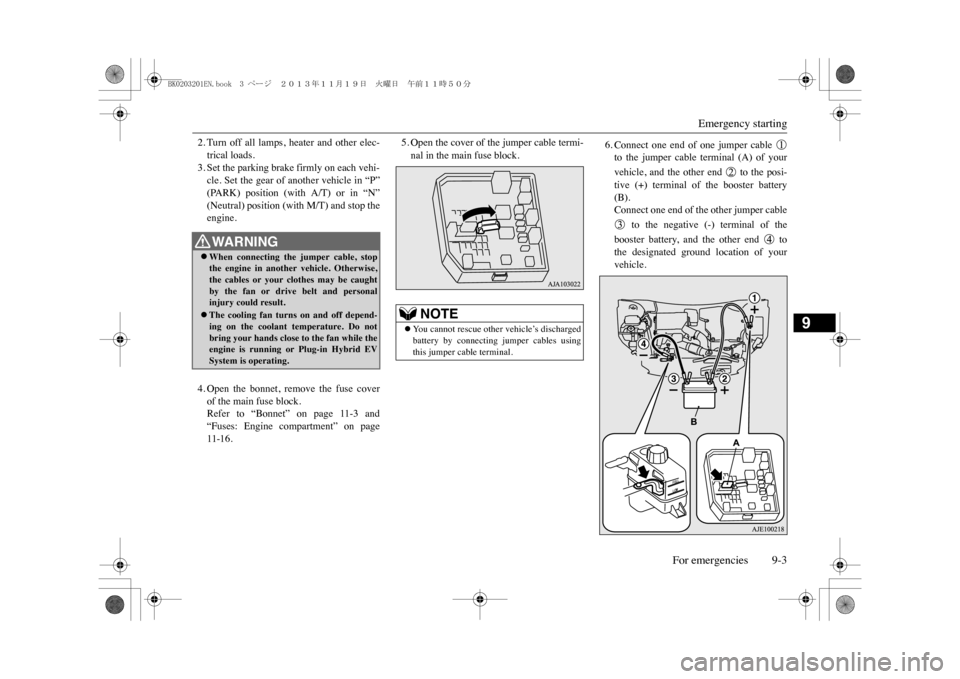
Emergency starting
For emergencies 9-3
9
2. Turn off all lamps, heater and other elec-trical loads.3. Set the parking brake firmly on each vehi-cle. Set the gear of another vehicle in “P”(PARK) position (with A/T) or in “N”(Neutral) position (with M/T) and stop theengine.4. Open the bonnet, remove the fuse coverof the main fuse block.Refer to “Bonnet” on page 11-3 and“Fuses: Engine compartment” on page11-16.
5. Open the cover of the jumper cable termi-nal in the main fuse block.
6. Connect one end of one jumper cable to the jumper cable terminal (A) of yourvehicle, and the other end to the posi-tive (+) terminal of the booster battery(B).Connect one end of the other jumper cable to the negative (-) terminal of thebooster battery, and the other end tothe designated ground location of yourvehicle.
WA R N I N G�zWhen connecting the jumper cable, stopthe engine in another vehicle. Otherwise,the cables or your cl
othes may be caught
by the fan or drive belt and personalinjury could result.�zThe cooling fan turns on and off depend-ing on the coolant temperature. Do notbring your hands close to the fan while theengine is running or Plug-in Hybrid EVSystem is operating.
NOTE
�zYo u c a n n o t r e s c u e o t h e
r vehicle’s discharged
battery by connecting jumper cables usingthis jumper cable terminal.
BK0203201EN.book 3 ページ 2013年11月19日 火曜日 午前11時50分
Page 315 of 388
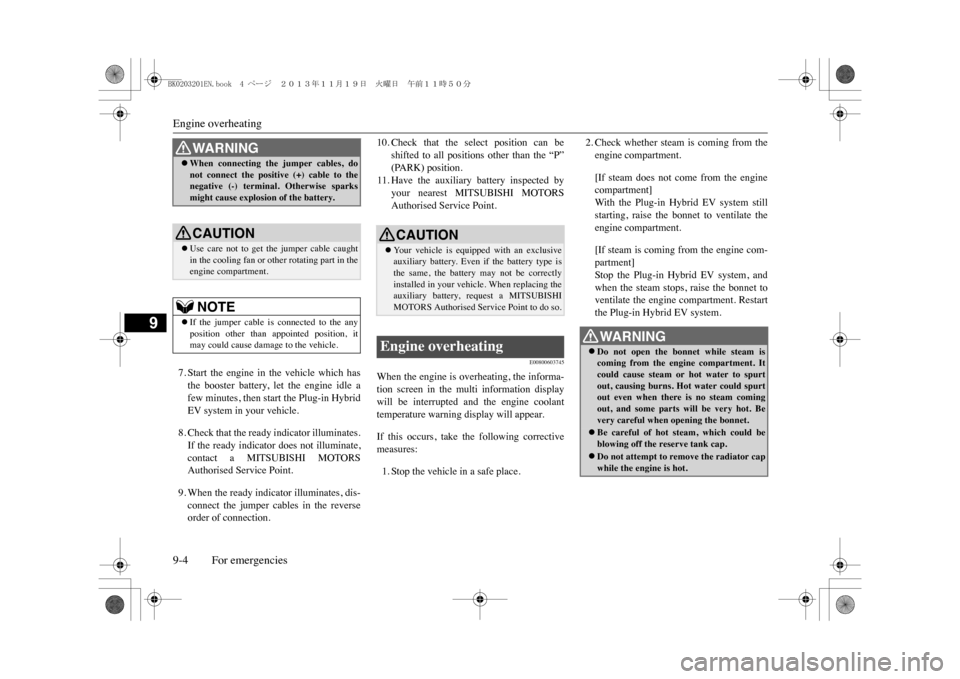
Engine overheating9-4 For emergencies
9
7. Start the engine in the vehicle which hasthe booster battery, let the engine idle afew minutes, then start the Plug-in HybridEV system in your vehicle.8. Check that the ready indicator illuminates.If the ready indicator does not illuminate,contact a MITSUBISHI MOTORSAuthorised Service Point.9. When the ready indicator illuminates, dis-connect the jumper cables in the reverseorder of connection.
10. Check that the select position can be
shifted to all positions other than the “P”(PARK) position.
11. Have the auxiliary battery inspected by
your nearest MITSUBISHI MOTORSAuthorised Service Point.
E00800603745
When the engine is overheating, the informa-tion screen in the multi information displaywill be interrupted and the engine coolanttemperature warning display will appear.If this occurs, take the following correctivemeasures:1. Stop the vehicle in a safe place.
2. Check whether steam is coming from theengine compartment.[If steam does not come from the enginecompartment]Wi t h t h e Pl ug - i n H yb r i d E V s ys t em s t i l lstarting, raise the bonnet to ventilate theengine compartment.[If steam is coming from the engine com-partment]Stop the Plug-in Hybrid EV system, andwhen the steam stops, raise the bonnet toventilate the engine compartment. Restartthe Plug-in Hybrid EV system.
WA R N I N G�zWhen connecting the jumper cables, donot connect the positive (+) cable to thenegative (-) terminal. Otherwise sparksmight cause explosion of the battery.CAUTION�zUse care not to get the jumper cable caughtin the cooling fan or other rotating part in theengine compartment.NOTE
�zIf the jumper cable is
connected to the any
position other than a
ppointed position, it
may could cause damage to the vehicle.
CAUTION�zYo u r v e h i c l e i s e q u i p p e d w i t h a n e x c l u s i v eauxiliary battery. Even if the battery type isthe same, the battery may not be correctlyinstalled in your vehicle. When replacing theauxiliary battery, request a MITSUBISHIMOTORS Authorised Service Point to do so.
Engine overheating
WA R N I N G�zDo not open the bonnet while steam iscoming from the engine compartment. Itcould cause steam or hot water to spurtout, causing burns. Hot water could spurtout even when there is no steam comingout, and some parts will be very hot. Bevery careful when opening the bonnet.�zBe careful of hot steam, which could beblowing off the reserve tank cap.�zDo not attempt to remove the radiator capwhile the engine is hot.
BK0203201EN.book 4 ページ 2013年11月19日 火曜日 午前11時50分
Page 340 of 388

Cleaning the exterior of your vehicle
Vehicle care 10-5
10
The salt and other chemicals spread on theroads in some areas in winter can have aharmful effect on the vehicle body. Youshould therefore wash the vehicle as often aspossible in accordance with our care-instruc-tions. It is recommended to have a preserva-tive applied and the underfloor protectionchecked before and after the cold weatherseason.After washing your vehicle, wipe off allwaterdrops from the rubber parts around thedoors to prevent the doors from freezing.
E00901000919
Wa x i n g t h e v e h i c l e w i l l h e l p p r e v e n t t h eadherence of dust and road chemicals to thepaintwork. Apply a wax solution after wash-ing the vehicle, or at least once every threemonths to assist di
splacing of water.
Do not wax your vehicle in direct sunlight.Yo u s h o u l d w a x a f t e r t h e s u r f a c e s h a v ecooled.For information on how to use wax refer tothe instruction manual of the wax.
E00901100066
The vehicle should only be polished if thepaintwork has become stained or lost its lus-tre. Do not polish parts with a mat coatingand the plastic bumpers. Doing so couldcause stains or damage the finish.
E00901300808
Use a sponge or chamois leather.If a car wax adheres on a grey or black roughsurface of the bumper, moulding or lamps,the surface becomes white. In such a case,wipe it off using lukewarm water and softcloth or chamois leather.
E00901400098
In order to prevent spots and corrosion ofchrome parts, wash with water, dry thor-oughly, and apply a special protective coat-ing. This should be done more frequently inwinter.
•If your vehicle is equi
pped with a roof rails,
consult a car wash opera
tor before using the
car washer.•If your vehicle has rain
sensor wipers, place
the wiper switch lever in the “OFF” posi-tion to deactivate the rain sensor.
During cold weather
NOTE
�zTo p r e v e n t f r e e z i n g o f
the weatherstripping
on the doors, bonnet, etc., they should betreated with silicone spray.CAUTION
Wa x in g
CAUTION�zWa x e s c o n t a i n i n g h i
gh abrasive compounds
should not be used.�zOn vehicles with the sunroof, be carefulwhen waxing the area around the sunroofopening, not to put any wax on the weather-strip (black rubber). If stained with wax, theweatherstrip cannot maintain a weatherproofseal with the sunroof.
Polishing
Cleaning plastic parts
CAUTION�zDo not use a scrubbing brush or other hardtools as they may damage the plastic partsurface.�zDo not bring the plastic parts into contactwith petrol, light oil,
brake fluids, engine
oils, greases, paint thinners, and sulphuricacid (battery electrolyte) which may crack,stain or discolour
the plastic parts.
If they touch the plastic
parts, wipe them off
with soft cloth, chamois or the like and anaqueous solution of neutral detergent thenimmediately rinse the affected parts withwater.
Chrome parts
BK0203201EN.book 5 ページ 2013年11月19日 火曜日 午前11時50分
Page 342 of 388

11
MaintenanceService precautions ......................................................................... 11-2Catalytic converter .......................................................................... 11-3Bonnet ............................................................................................. 11-3Engine oil ........................................................................................ 11-5Engine coolant/Plug-in hybrid EV system coolant ......................... 11-6Wa s h e r f l u i d . . . . . . . . . . . . . . . . . . . . . . . . . . . . . . . . . . . . . . . . . . . . . . . . . . . . . . . . . . . . . . . . . . . . . . . . . . . . . . . . . . . . 11 - 7Brake fluid ...................................................................................... 11-7Auxiliary battery ............................................................................. 11-8Ty r e s . . . . . . . . . . . . . . . . . . . . . . . . . . . . . . . . . . . . . . . . . . . . . . . . . . . . . . . . . . . . . . . . . . . . . . . . . . . . . . . . . . . . . . . . . . . . . . . 11 - 9Wiper blade rubber replacement ................................................... 11-12General maintenance .................................................................... 11-14Fusible links .................................................................................. 11-15Fuses ............................................................................................. 11-15Replacement of lamp bulbs .......................................................... 11-21
BK0203201EN.book 1 ページ 2013年11月19日 火曜日 午前11時50分
Page 344 of 388
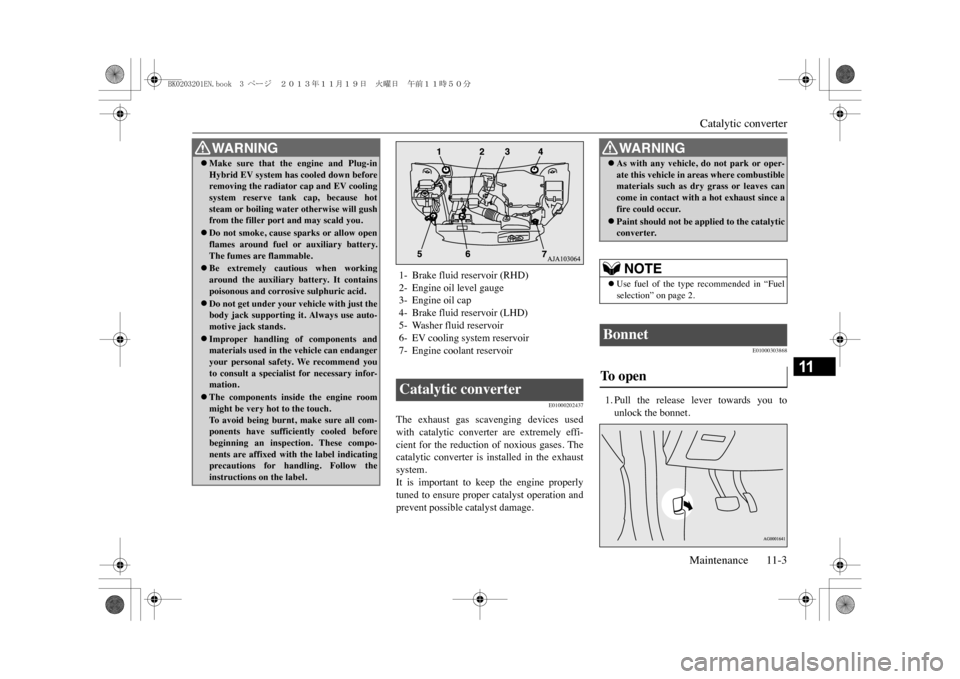
Catalytic converterMaintenance 11-3
11
E01000202437
The exhaust gas scavenging devices usedwith catalytic converter are extremely effi-cient for the reduction of noxious gases. Thecatalytic converter is installed in the exhaustsystem.It is important to keep the engine properlytuned to ensure proper catalyst operation andprevent possible catalyst damage.
E01000303868
1. Pull the release lever towards you tounlock the bonnet.
�zMake sure that the engine and Plug-inHybrid EV system has cooled down beforeremoving the radiator cap and EV coolingsystem reserve tank cap, because hotsteam or boiling water otherwise will gushfrom the filler port and may scald you.�zDo not smoke, cause sparks or allow openflames around fuel or auxiliary battery.The fumes are flammable.�zBe extremely cautious when workingaround the auxiliary battery. It containspoisonous and corrosive sulphuric acid.�zDo not get under your vehicle with just thebody jack supporting it. Always use auto-motive jack stands.�zImproper handling of
components and
materials used in the vehicle can endangeryour personal safety. We recommend youto consult a specialist for necessary infor-mation.�zThe components inside the engine roommight be very hot to the touch.To a v o i d b e i n g b u r n t , m a k e s u r e a l l c o m -ponents have sufficiently cooled beforebeginning an inspection. These compo-nents are affixed with the label indicatingprecautions for handling. Follow theinstructions on the label.WA R N I N G
1- Brake fluid reservoir (RHD)2- Engine oil level gauge3- Engine oil cap4- Brake fluid reservoir (LHD)5- Washer fluid reservoir6- EV cooling system reservoir7- Engine coolant reservoirCatalytic converter
WA R N I N G�zAs with any vehicle, do not park or oper-ate this vehicle in areas where combustiblematerials such as dry grass or leaves cancome in contact with a hot exhaust since afire could occur.�zPaint should not be applied to the catalyticconverter.NOTE
�zUse fuel of the type recommended in “Fuelselection” on page 2.
Bonnet To o p e n
BK0203201EN.book 3 ページ 2013年11月19日 火曜日 午前11時50分
Page 345 of 388
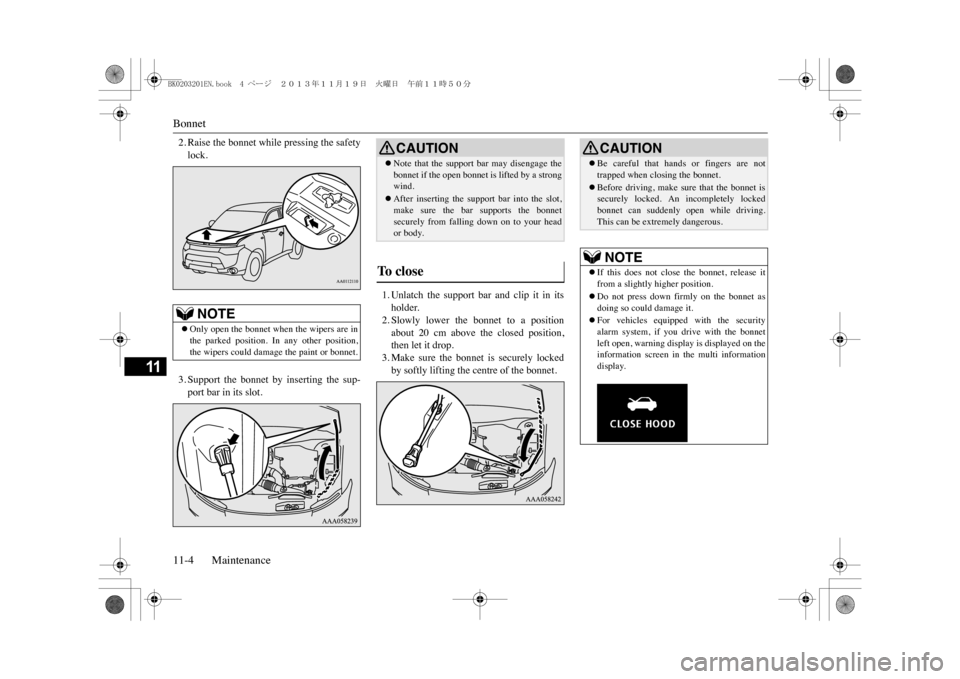
Bonnet11-4 Maintenance
11
2. Raise the bonnet while pressing the safetylock.3. Support the bonnet by inserting the sup-port bar in its slot.
1. Unlatch the support bar and clip it in itsholder.2. Slowly lower the bonnet to a positionabout 20 cm above the closed position,then let it drop.3. Make sure the bonnet is securely lockedby softly lifting the centre of the bonnet.
NOTE
�zOnly open the bonnet when the wipers are inthe parked position. In any other position,the wipers could damage the paint or bonnet.
CAUTION�zNote that the support bar may disengage thebonnet if the open bonnet is lifted by a strongwind.�zAfter inserting the support bar into the slot,make sure the bar supports the bonnetsecurely from falling down on to your heador body.
To c l o s e
CAUTION�zBe careful that hands or fingers are nottrapped when closing the bonnet.�zBefore driving, make sure that the bonnet issecurely locked. An
incompletely locked
bonnet can suddenly open while driving.This can be extremely dangerous.NOTE
�zIf this does not close
the bonnet, release it
from a slightly higher position.�zDo not press down firmly on the bonnet asdoing so could damage it.�zFor vehicles equipped with the securityalarm system, if you drive with the bonnetleft open, warn
ing display is displayed on the
information screen in the multi informationdisplay.
BK0203201EN.book 4 ページ 2013年11月19日 火曜日 午前11時50分
Page 349 of 388

Auxiliary battery11-8 Maintenance
11
The fluid level is monitored by a float. Whenthe fluid level falls below the “MIN” mark,the brake fluid warning lamp lights up.The fluid level falls slightly with wear of thebrake pads, but this does not indicate anyabnormality.The fluid in the master cylinder should bechecked when doing other work under the
bonnet. The brake system should also bechecked for leaks at the same time.If the fluid level falls markedly in a shortlength of time, it indicates leaks from thebrake system.If this occurs, we recommend you to have thevehicle checked.Use brake fluid conforming to DOT3 orDOT4 from a sealed container. The brakefluid is hygroscopic. Too much moisture inthe brake fluid will adversely affect the brakesystem, reducing the performance.
E01001203284
The condition of the auxiliary battery is veryimportant for quick starting of the plug-inhybrid EV system and proper functioning ofthe vehicle’s electrical system. Regularinspection is especially important in coldweather. Be sure to have a MITSUBISHIMOTORS Authorized Service Point checkthe auxiliary battery.
LHDRHD
Fluid type
CAUTION�zTa k e c a r e i n h a n d l i n g b r a k e f l u i d a s i t i sharmful to the eyes,
may irritate your skin
and also damage to painted surfaces.�zUse only the specified brake fluid.Do not mix or add different brand of brakefluid to prevent chemical reaction.Do not let any petrol
eum-based fluid touch,
mix with, or get into the brake fluid.This will damage the seals.�zKeep the reservoir tank cap closed to preventthe brake fluid from deteriorating exceptmaintenance.�zClean the filler cap before removing andclose the cap securely after maintenance.
Auxiliary battery
WA R N I N G�zBe sure to have a MITSUBISHI MOTORSAuthorized Service Point charge the bat-tery. Do not charge the battery yourself.Flammable gases may leak and explode.CAUTION�zThere is a type of auxiliary battery is notproperly installed in the vehicle, even if thesame specification.When replacing the auxiliary battery, pleasecontact a MITSUBISHI MOTORS Author-ized Service Point.
BK0203201EN.book 8 ページ 2013年11月19日 火曜日 午前11時50分
Page 382 of 388
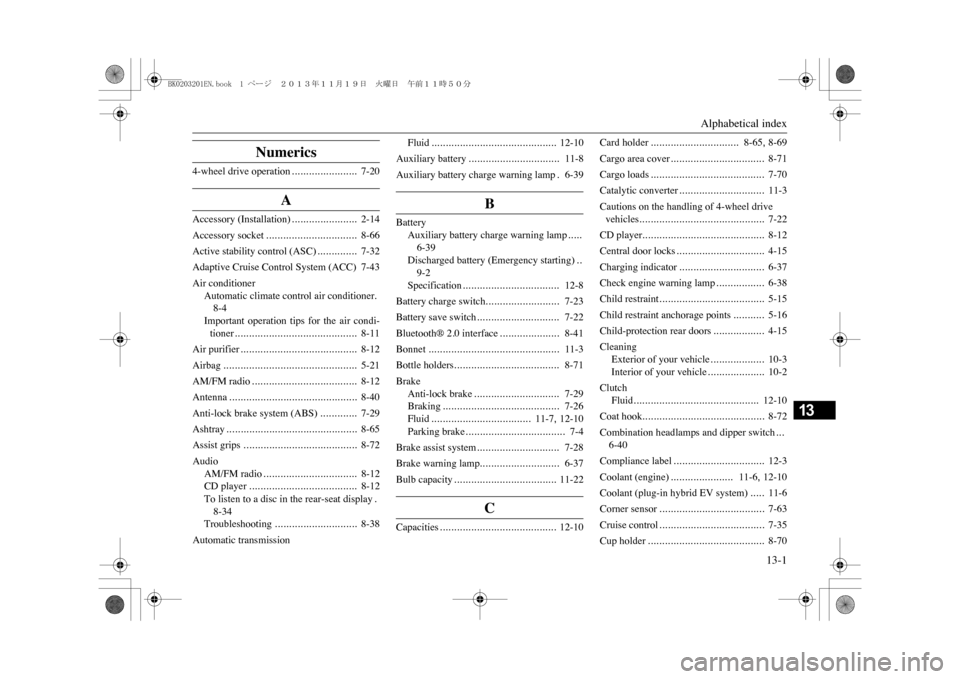
Alphabetical index
13-1
13
Numerics
4-wheel drive operation
.......................
7-20
A
Accessory (Installation)
.......................
2-14
Accessory socket
................................
8-66
Active stability control (ASC)
..............
7-32
Adaptive Cruise Control System (ACC) 7-43Air conditioner
Automatic climate control air conditioner
.
8-4Important operation tips for the air condi-tioner
...........................................
8-11
Air purifier
.........................................
8-12
Airbag
...............................................
5-21
AM/FM radio
.....................................
8-12
Antenna
.............................................
8-40
Anti-lock brake system (ABS)
.............
7-29
Ashtray
..............................................
8-65
Assist grips
........................................
8-72
Audio
AM/FM radio
.................................
8-12
CD player
......................................
8-12
To listen to a disc in the rear-seat display
.
8-34Troubleshooting
.............................
8-38
Automatic transmission
Fluid
............................................
12-10
Auxiliary battery
................................
11-8
Auxiliary battery charge warning lamp
.6-39
B
Battery
Auxiliary battery charge warning lamp
.....
6-39Discharged battery (Emergency starting)
..
9-2Specification
..................................
12-8
Battery charge switch
..........................
7-23
Battery save switch
.............................
7-22
Bluetooth® 2.0 interface
.....................
8-41
Bonnet
..............................................
11-3
Bottle holders
.....................................
8-71
Brake
Anti-lock brake
..............................
7-29
Braking
.........................................
7-26
Fluid
...................................
11-7
, 12-10
Parking brake
...................................
7-4
Brake assist system
.............................
7-28
Brake warning lamp
............................
6-37
Bulb capacity
....................................
11-22
C
Capacities
.........................................
12-10
Card holder
...............................
8-65
, 8-69
Cargo area cover
.................................
8-71
Cargo loads
........................................
7-70
Catalytic converter
..............................
11-3
Cautions on the handling of 4-wheel drive vehicles
............................................
7-22
CD player
...........................................
8-12
Central door locks
...............................
4-15
Charging indicator
..............................
6-37
Check engine warning lamp
.................
6-38
Child restraint
.....................................
5-15
Child restraint anchorage points
...........
5-16
Child-protection rear doors
..................
4-15
Cleaning
Exterior of your vehicle
...................
10-3
Interior of your vehicle
....................
10-2
Clutch
Fluid
............................................
12-10
Coat hook
...........................................
8-72
Combination headlamps and dipper switch
...
6-40Compliance label
................................
12-3
Coolant (engine)
......................
11-6
, 12-10
Coolant (plug-in hybrid EV system)
.....
11-6
Corner sensor
.....................................
7-63
Cruise control
.....................................
7-35
Cup holder
.........................................
8-70
BK0203201EN.book 1 ページ 2013年11月19日 火曜日 午前11時50分